Greek-inspired interior design captures the essence of Mediterranean charm. It blends the serenity of the Aegean Sea with the rustic elegance of ancient architecture. This design philosophy is a celebration of light, natural beauty, and minimalist grace. It invites an atmosphere of calm and clarity into the home.
At the heart of Greek interior design lies an unwavering commitment to simplicity and functionality. Also, every element serves a purpose. Aesthetic balance is achieved through uncluttered spaces.
Central to this design theme are natural elements that echo the landscapes of Greece. Stone, wood, and linen come together to create spaces that feel both grounded and ethereal.
These materials are chosen for their beauty and durability. They are also chosen for their ability to age gracefully, acquiring character over time. The incorporation of natural elements brings the outdoors inside. It fosters a seamless connection with nature that is both refreshing and rejuvenating.
A Palette of Blue and White
Perhaps the most iconic aspect of Greek-inspired interiors is the distinctive blue-and-white color palette. This combination is visually striking. It is also deeply symbolic, reflecting the hues of the Greek flag. It evokes the clear skies and crystal waters of the Mediterranean.
White dominates the scheme, offering a cool, reflective canvas. It amplifies natural light and enhances the sense of space. Accents of vibrant blue breathe life and energy into the design. So, they create a dynamic interplay of color that mirrors the spirit of Greece itself.
Greek-inspired interior design is more than just a style. It’s a reflection of a lifestyle that values beauty, simplicity, and harmony with the natural world.
It invites us to strip away the unnecessary and focus on what truly matters. It encourages us to infuse our homes with elements that speak to our souls. In embracing Greek design principles, we open our spaces to the timeless allure of the Mediterranean. Our homes become bright, airy, and endlessly inviting.
1. Herb Planters in Greek Mediterranean Interior Design
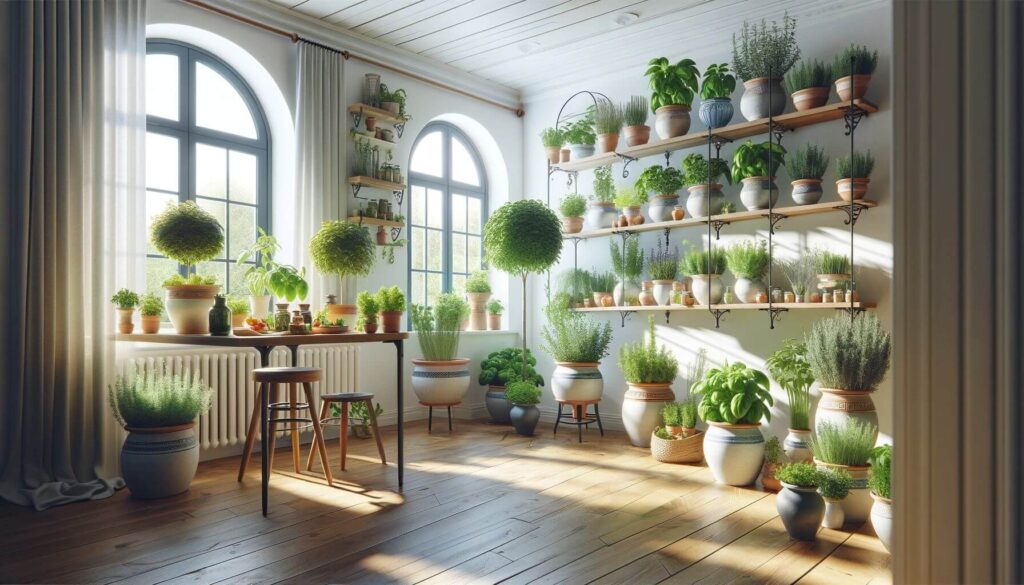
Incorporating herb planters into your Greek interior design brings a touch of vibrant greenery into your home. It also adds a practical element that harks back to the Mediterranean lifestyle.
Herbs like rosemary, thyme, and oregano are staples in Greek cuisine. They can be grown right in your kitchen or balcony. This offers fresh flavors at your fingertips and infuses your space with their fragrant aromas. Terracotta pots, often used for these planters, further accentuate the Greek aesthetic. They add warmth and authenticity.
This integration of herb planters enhances the connection to nature and the tradition of home cooking. It makes your kitchen or dining area not just a place of culinary preparation but a lively and aromatic retreat.
2. Canopy Beds in Greek Home Interior

Canopy beds introduce a sense of romance and grandeur reminiscent of ancient Greek living quarters, where drapery and textiles played a significant role in interior décor. In a modern Greek-inspired bedroom, a canopy bed can serve as a dramatic focal point, its flowing fabrics adding texture and a sense of softness to the room.
The light, airy fabrics used for the canopy can help to diffuse natural light, creating a serene and inviting ambiance. This design element not only adds visual interest but also offers a nod to the luxury and sophistication of Greek interiors, inviting you to rest in a space that feels both timeless and out of the world.
3. Greek Key Patterns
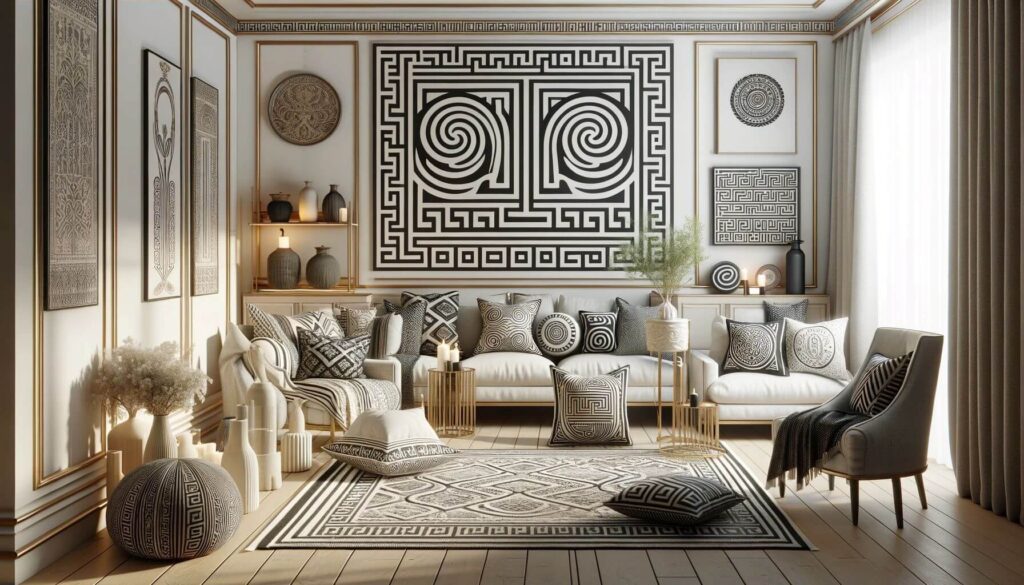
The Greek key pattern, also known as meander, is a continuous line shaped into a repeated motif. It symbolizes infinity and the eternal flow of life. This classic decorative element is deeply rooted in ancient Greek art and architecture. Its inclusion in modern Greek-inspired interiors adds a layer of historical significance and visual appeal.
The Greek key can be found in everything from wallpaper borders and floor tiles to textiles and furniture detailing. It offers a versatile way to incorporate this iconic design into your home. Utilizing the Greek key pattern in your decor pays homage to the artistry of ancient Greece. It also introduces a geometric element that is both sophisticated and timeless. It seamlessly blends with the minimalist and natural aesthetic of Greek-inspired design.
4. Sea and Sky Imagery Greek Inspired Decor

Incorporating artwork or photographic prints that capture the ethereal beauty of the Greek sea and sky can significantly enhance the ambiance of your Greek-inspired interior. These elements emphasize the natural color palette, with hues of deep blue, turquoise, and azure reflecting the sea, contrasted against the soft whites and light blues of the sky.
This visual homage to the Greek landscape serves not only as a decorative choice but also as a way to open up the space, bringing the tranquility and vastness of the Aegean Sea into your home. Displaying these images in strategic locations can create focal points that draw the eye, fostering a sense of calm and inspiration, and deepening the connection to the natural wonders of Greece.
5. Hellenic-inspired Sculptures Design Idea
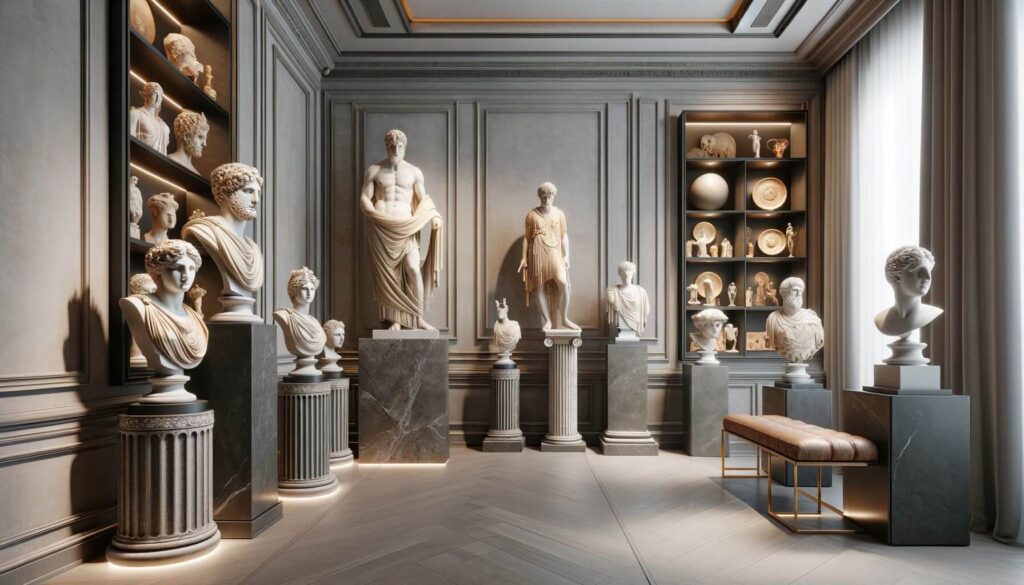
Displaying sculptures that echo the art of ancient Greece, such as busts, figures, or replicas of famous archaeological finds, adds an artistic and historical touch to your interior design. These pieces serve as a bridge to the past, embodying the grace, beauty, and philosophical ideals of ancient Greek culture.
Placing Hellenic-inspired sculptures in your home not only enhances its aesthetic appeal but also imbues it with a sense of timelessness and sophistication. These ancient greek interior design sculptures can be used as central pieces in a room, on mantelpieces, or within niches, acting as conversation starters and showcasing your appreciation for the rich cultural heritage and artistic achievements of ancient Greece.
6. Pebble Mosaic Pathways

Creating pebble mosaic pathways or accents in outdoor spaces pays tribute to the ancient Greek tradition of pebble art, a decorative form that dates back to the Hellenistic period. This intricate art form involves arranging small pebbles into patterns or images, often depicting scenes from mythology, nature, or geometric designs.
Incorporating pebble mosaics in garden pathways, patios, or as decorative accents around the home brings a piece of Greek history into your personal space, blending art with nature. The natural colors and textures of the pebbles enhance the outdoor area’s aesthetic, offering a unique and timeless appeal that connects modern living spaces to the ancient world. This traditional greek house design not only beautifies the outdoor environment but also creates a tactile, visually engaging experience that evokes the craftsmanship and creativity of Greek artisans.
7. Breezy Window Treatments

To truly capture the essence of Greek-inspired interior design, consider hanging light, gauzy curtains that billow with the breeze, enhancing the light and airy ambiance characteristic of Greek homes. These window treatments allow natural light to filter through, softly diffusing it throughout the space and creating a warm, welcoming environment.
The movement of the curtains with the air adds a dynamic element, bringing a sense of the outdoors inside and mimicking the serene, laid-back lifestyle of the Mediterranean. Opting for fabrics in white or light blues can further complement the Greek color palette, reinforcing the connection to the sea and sky.
This approach to window treatments not only elevates the aesthetic of the room but also fosters a tranquil, open atmosphere, making spaces feel more expansive and connected to the natural world.
8. Ancient Greek Interior Design with Sunken Seating Areas

Designing a sunken seating area in your home can introduce an element of ancient Greek interior design architecture that is both historical and incredibly modern in its appeal. Reminiscent of the ancient Greek symposiums, where philosophers and thinkers would gather for conversation and wine, these areas offer a unique space for relaxation, conversation, and entertainment.
By blending historical inspiration with modern comfort, sunken seating areas can become the heart of the home, fostering a sense of intimacy and togetherness among family and guests. Incorporating comfortable cushions, throw pillows in hues of blue and white, and natural materials such as stone or wood can enhance the aesthetic, creating a cozy yet elegant greek living room that encourages social interaction and leisure.
9. Whitewashed Walls Greek Home Decor
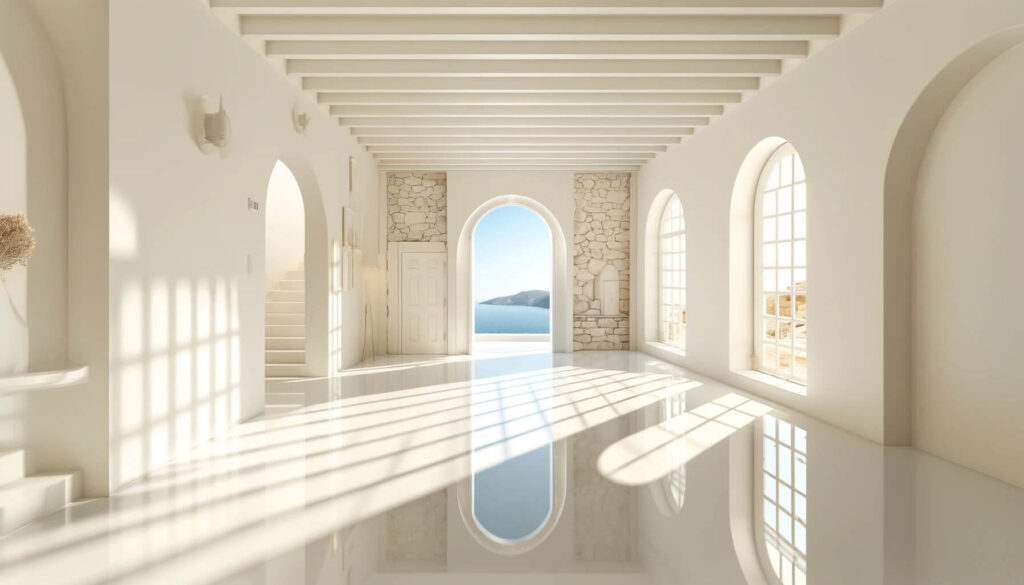
Whitewashed walls are a quintessential element of Greek-inspired interior design, embodying the essence of Mediterranean charm and simplicity. This design choice is deeply rooted in Greece’s historical and geographical landscape, reflecting the sun-drenched houses of the Greek islands.
The importance of whitewashed walls in greek home decor lies in their ability to create a bright, airy aesthetic that maximizes natural light, making spaces appear larger and more open. The reflective quality of the white surfaces bounces light around the room, enhancing the sense of airiness and freshness.
This not only contributes to a visually appealing space but also promotes a calm and serene atmosphere, reminiscent of the tranquil Greek coastline. Whitewashed walls serve as a versatile backdrop, allowing other design elements, such as color and texture, to stand out, providing a canvas that is both grounding and invigorating.
10. Greek Mediterranean Interior Design with Blue Accents
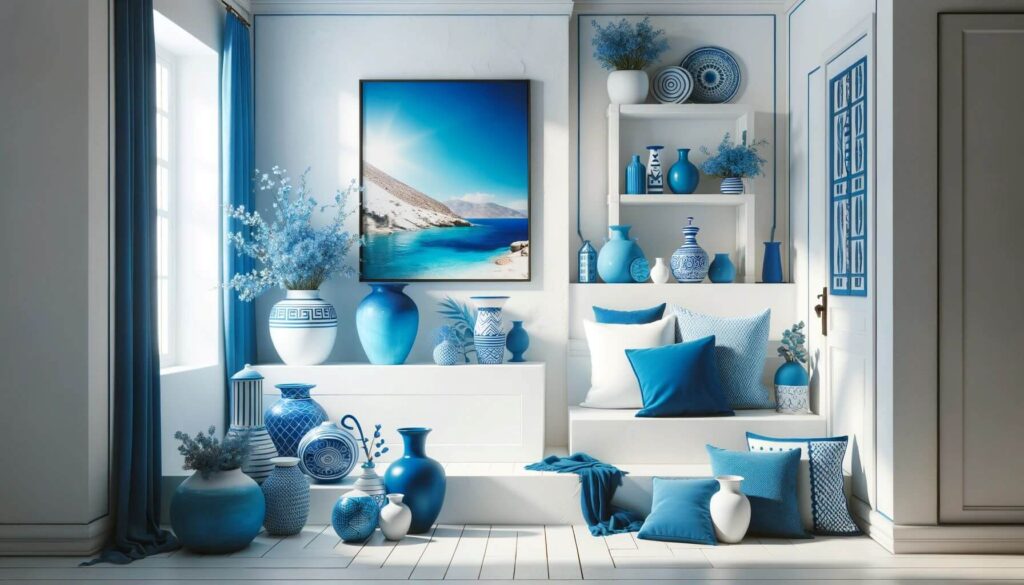
Incorporating vibrant blue accents into a Greek inspired interior design scheme captures the spirit of the Aegean Sea, bringing the beauty of Greece’s natural landscape indoors. Blue, a color that symbolizes tranquility, depth, and harmony, complements the starkness of whitewashed walls beautifully, creating a striking contrast that is both refreshing and visually dynamic.
To incorporate blue accents effectively, consider using textiles like throw pillows, rugs, or curtains in various shades of blue, from the deep navy reminiscent of the sea’s depth to the bright turquoise of its shallows. Decorative items such as vases, wall art, and ceramics can also introduce blue tones, adding layers of color and interest.
The key is to balance these accents throughout the space, ensuring they enhance rather than overwhelm the room’s aesthetic. By mirroring the Aegean Sea’s captivating hues, blue accents not only enrich the visual palette but also evoke a sense of calm and connection to the Greek maritime landscape.
11. Natural Stone Floors
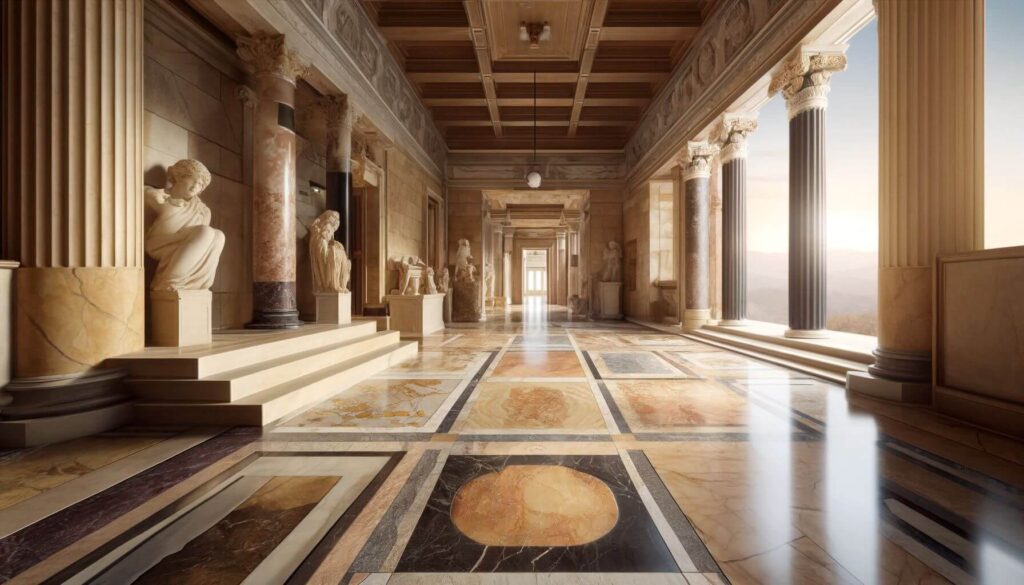
The allure of Greek interior design style extends beneath our feet, through the use of natural stone floors. This element is not just a nod to the ancient architecture of Greece, where stone was a fundamental building material, but also a testament to the beauty and practicality of incorporating natural elements into our homes.
Stone floors, with their cool, hard surface, are ideal for warm climates, providing a natural cooling effect in the summer months. The variation in textures and colors, from the soft grays of marble to the warm hues of limestone, adds depth and character to any space.
For those looking for a more cost-effective or practical solution, stone-effect tiles offer a similar aesthetic with added durability and ease of maintenance. Whether real or replicated, stone floors lay the foundation for a Greek-inspired aesthetic, grounding the space in the natural world and creating a seamless flow from the outdoors in.
12. Open Spaces and Minimalism
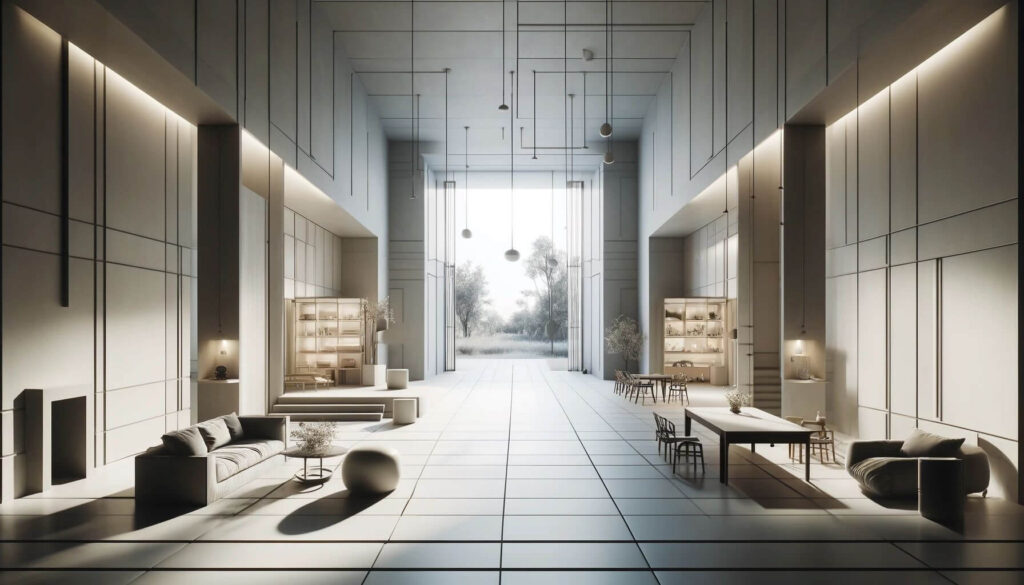
In Greek-inspired interiors, the ethos of simplicity is king, and this is nowhere more apparent than in the emphasis on open spaces and minimalism. This design principle is about more than just aesthetic appeal; it’s a reflection of a lifestyle that values freedom, movement, and the luxury of space.
By creating open, uncluttered spaces, the design encourages a flow of energy and light throughout the home, making rooms feel larger and more inviting. Furniture is chosen for its functionality and beauty, with each piece serving a purpose, avoiding unnecessary decoration or clutter.
This minimalist approach not only pays homage to the ancient Greek ideal of symmetry and balance but also speaks to modern desires for a tranquil, unburdened living environment. In embracing minimalism, the design fosters a sense of peace and clarity, allowing the natural beauty of the architecture and selected materials to shine through.
13. Terracotta Pots and Vases
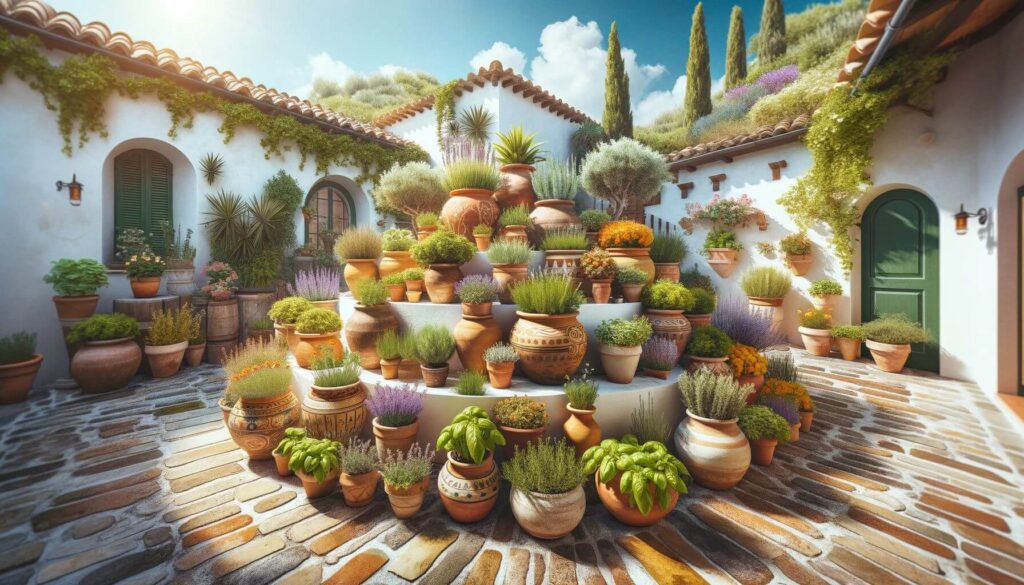
Terracotta, with its rich, earthy tones and rustic texture, is a material that evokes the warmth and charm of the Mediterranean. In Greek-inspired interior design, terracotta pots and vases are more than just decorative items; they are a link to the past, a nod to the traditional crafts and simple pleasures of Greek life.
These elements add warmth and authenticity to the space, bringing in color and a tactile quality that contrasts beautifully with the cool, smooth surfaces of stone and plaster. Terracotta’s natural material is perfect for indoor and outdoor use, ideal for housing everything from aromatic herbs to vibrant flowers, further blurring the lines between inside and outside. The use of terracotta pots and vases embodies the Greek appreciation for nature and craftsmanship, integrating functional beauty into the home’s design.
14. Mosaic Tiles
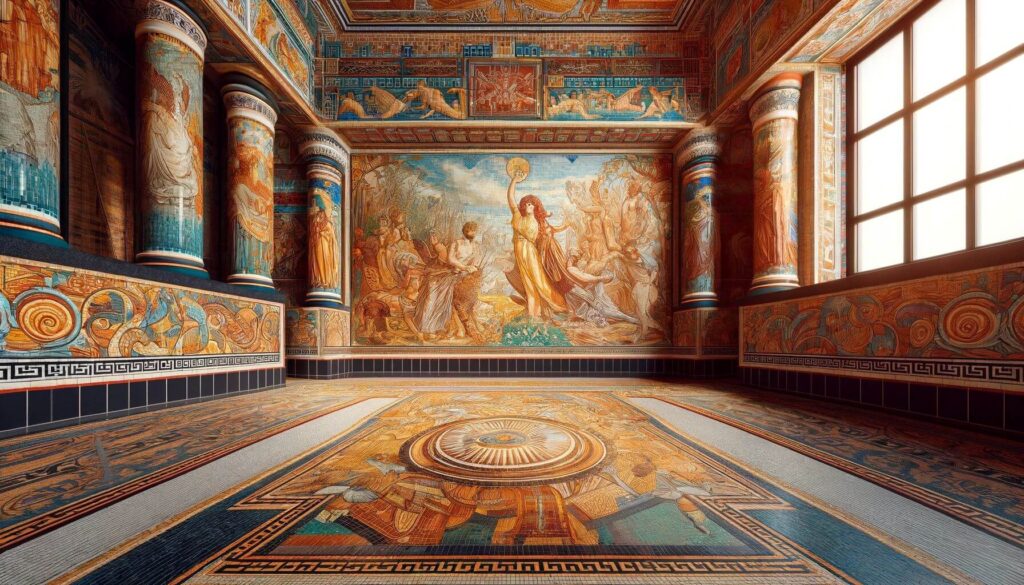
Mosaic tiles are a hallmark of Greek-inspired interior design. They offer a vibrant and artistic means to bring the rich tapestry of Greek art and mythology into the home. These intricate designs can range from geometric patterns to elaborate scenes depicting gods, goddesses, and mythological tales. The geometric patterns are emblematic of ancient Greek decor.
Incorporating mosaic tiles into flooring, backsplashes, or wall accents adds a layer of color and texture. It also infuses spaces with historical significance and storytelling.
The versatility of mosaics allows for customization in design themes. This enables a personal touch that can complement any part of the home, from bathrooms to kitchen islands. Through mosaic tiles, the enduring beauty of Greek culture is celebrated. They create focal points that are both visually stunning and deeply meaningful.
15. Textured Plaster Walls
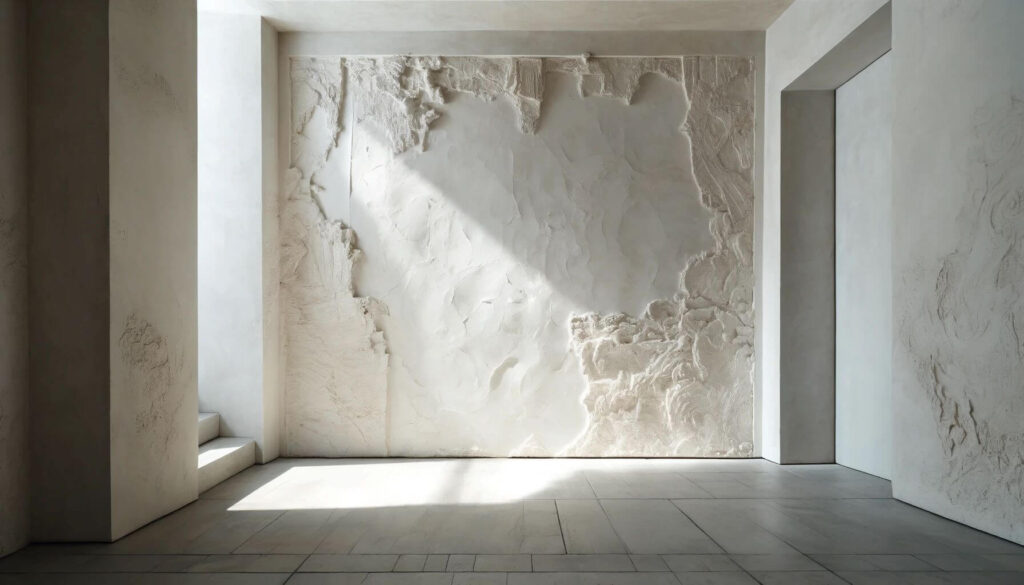
Textured plaster walls are a distinctive feature of Greek-inspired interiors. It contributes to the rustic and tactile appeal of the design aesthetic. This technique involves applying plaster in a way that leaves a deliberately imperfect, textured surface, mimicking the ancient walls found in traditional Greek architecture.
The beauty of textured plaster lies in its ability to add depth and character to a room, playing with light and shadow to create a dynamic visual effect. Moreover, the natural white or neutral tones of the plaster help in maintaining the bright and airy feel characteristic of Greek homes.
Beyond its aesthetic appeal, textured plaster is practical, offering durability and a timeless quality that does not fade with trends. This finish, when applied to walls or architectural features, brings a sense of the Mediterranean’s rustic charm into the home, blending perfectly with the minimalist and natural elements of Greek design.
16. Indoor-Outdoor Flow
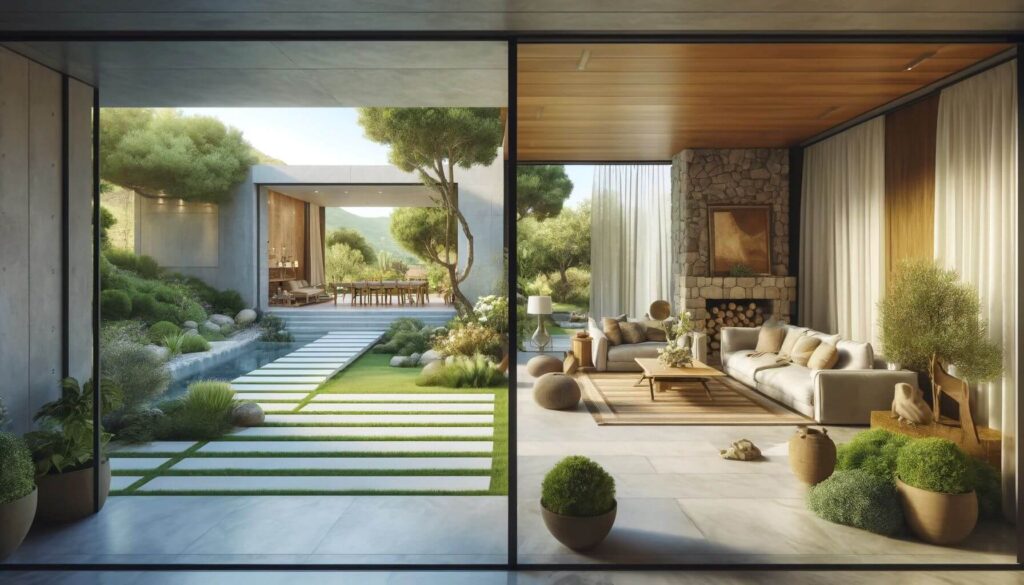
The concept of blending indoor and outdoor living spaces seamlessly is a pivotal aspect of Greek-inspired interior design, reflecting the Mediterranean lifestyle’s close connection with nature. This design principle is about erasing the boundaries between the inside of the home and the natural world outside, creating a living space that is both expansive and inclusive.
Large openings, such as sliding doors or panoramic windows, ensure a visual continuity between the interior and the garden, patio, or balcony. Materials like stone, wood, and terracotta are used both indoors and outdoors, further unifying the spaces.
Furniture and decor are chosen for their ability to transition effortlessly between environments, encouraging a lifestyle that embraces the outdoors for dining, relaxation, and entertainment. The indoor-outdoor flow not only enhances the aesthetic appeal of the home but also promotes a healthier, more relaxed way of living, where the beauty of nature is always within reach.
17. Mythological Art Pieces
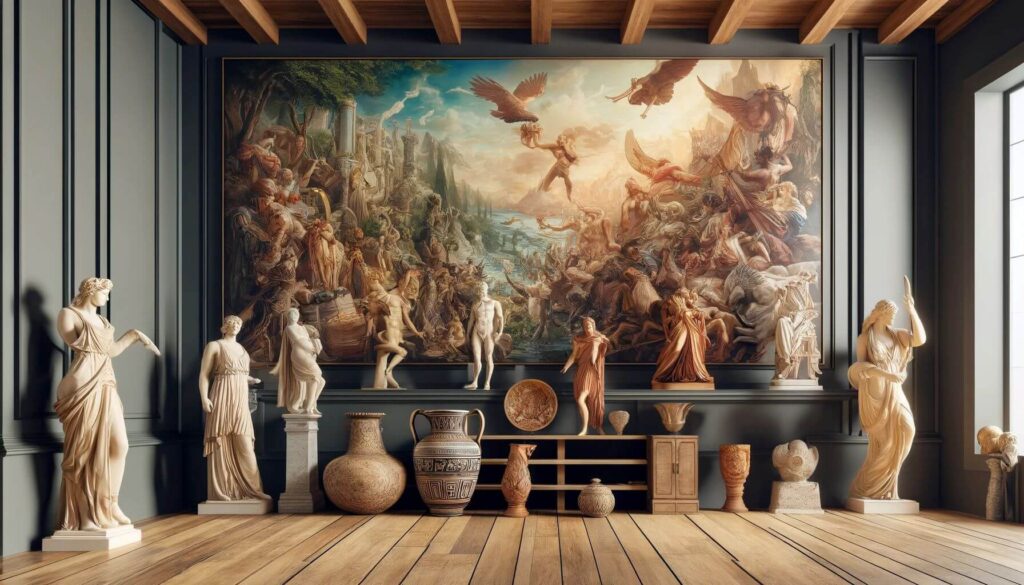
Incorporating art pieces that feature Greek mythology into your home decor is a powerful way to add a layer of cultural depth and storytelling. Greek mythology, rich with gods, goddesses, heroes, and mythical creatures, offers a vast source of inspiration for decorative elements.
Sculptures that mimic ancient statues can transform a space into a gallery of historical and cultural significance. Urns adorned with scenes of epic tales or paintings that capture the dramatic narratives of mythology can also achieve this effect.
These art pieces serve not only as beautiful decor but also as conversation starters. They imbue your home with a sense of mystery and wonder. By integrating mythological art, you honor the tradition of storytelling that was central to ancient Greek culture. This creates a space that feels both timeless and deeply connected to human history.
18. Olive Green Accents
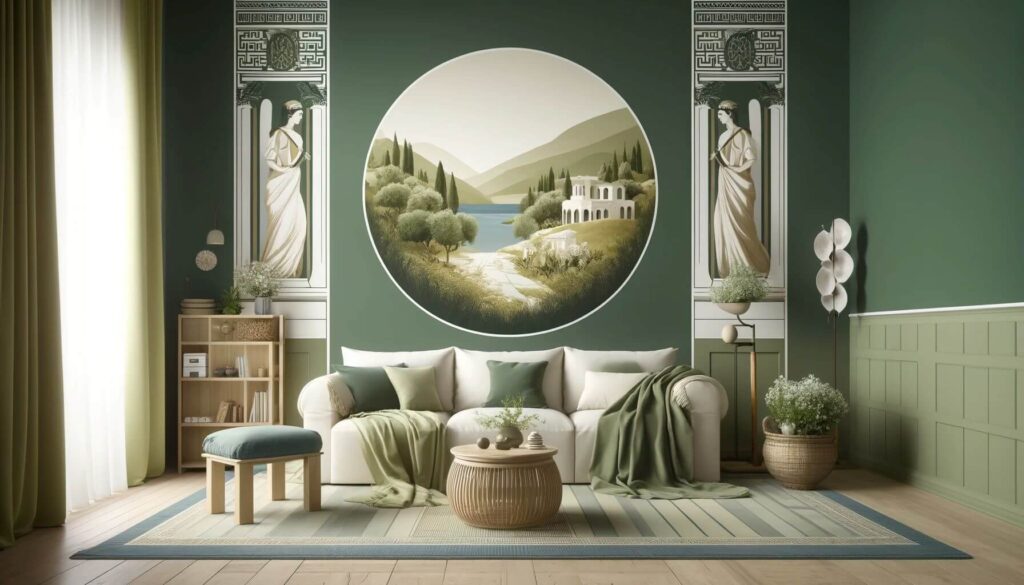
Introducing olive green into your interior design through textiles, wall color, or decorative accents is a subtle yet effective way to bring the essence of the Greek landscape indoors. Olive green is a color deeply rooted in the natural beauty of Greece. It can be found in the olive groves that blanket its hillsides and the lush foliage of its greek Mediterranean landscapes. This color adds a touch of nature’s serenity to your home.
Olive green works harmoniously with the classic Greek palette of white and blue. It offers a soft contrast that is both refreshing and calming. Olive green can be incorporated through various elements. These include throw pillows, curtains, wall paint, or even kitchen backsplash tiles. It brings a natural vibrancy that complements the light and airy feel of Greek-inspired design. The use of olive green not only enhances the aesthetic appeal of a space but also creates a connection to the natural world. It echoes the outdoor-focused lifestyle of the Mediterranean.
19. Rustic Wood Elements
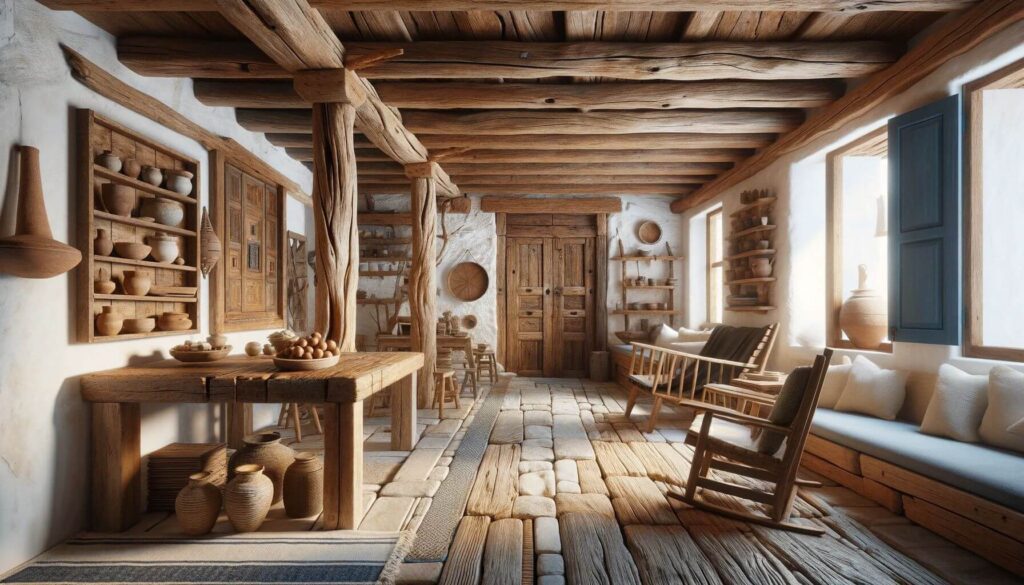
The use of rustic wood in furniture, beams, and accessories is essential in adding warmth and a touch of nature to Greece interior design. The natural imperfections and rich textures of rustic wood provide a beautiful contrast to the clean lines. It smoothes surfaces of whitewashed walls and stone floors. This brings balance and coziness to the space.
A handcrafted wooden table can serve as the heart of the dining room. Exposed beams add architectural interest to the ceiling. Wooden stools and accessories lend a casual, lived-in feel. These rustic wood elements are key to creating an inviting home. The warmth of the wood pairs beautifully with the traditional blue and white color scheme. It grounds the airy aesthetic with earthy tones.
Integrating rustic wood into your Greek-inspired decor adds visual interest and texture. It also pays homage to the importance of natural materials in Mediterranean architecture and design.
20. Greek Style Interior Design with Hand-Painted Ceramics
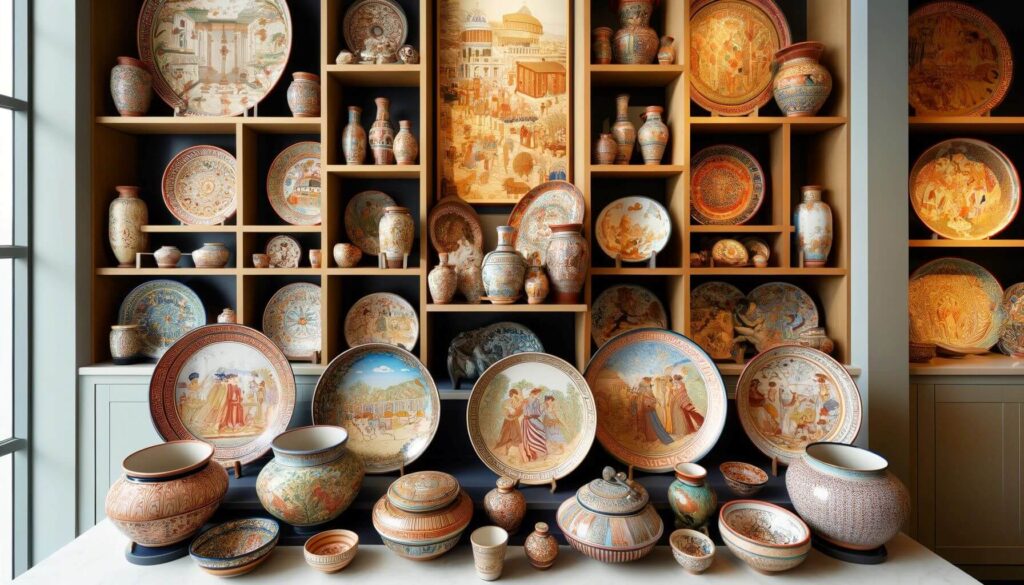
Decorating with hand-painted ceramic plates, bowls, and decorative items is a vibrant way to infuse your space with the essence of Greek culture and artistry. These ceramics often feature intricate Greek patterns, motifs from mythology, and scenes depicting daily life in ancient times. They are not just functional items but pieces of art that tell a story.
Displaying these items on open shelving brings a colorful and personal touch to the home. Using them as part of a wall gallery or even on the dining table also adds a personal touch. The craftsmanship and detail in each piece reflect a tradition of ceramic art. This tradition dates back thousands of years in Greece. They offer a connection to the past and a celebration of Greek heritage.
Hand-painted ceramics in a Greek-inspired interior add beauty and interest. They also create a sense of place, evoking the Mediterranean’s vivid landscapes and rich history.
21. Wrought Iron Details
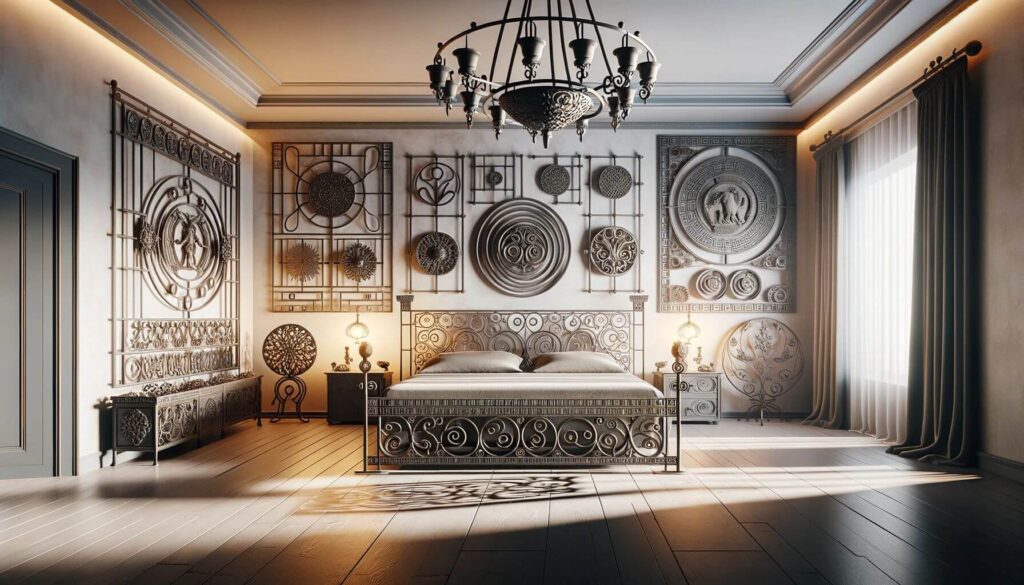
Incorporating wrought iron in light fixtures, furniture, or as decorative elements is a timeless way to add texture, strength, and historical reference to Greek-inspired interiors. Wrought iron is durable and flexible for intricate designs. It can be fashioned into beautiful patterns that echo Greek motifs or simple, elegant forms that complement the minimalist aesthetic.
A chandelier can cast intricate shadows across the room. A bed frame can balance solidity with grace. Decorative grilles and wall art can add depth and interest. Wrought iron brings a unique blend of functionality and artistry.
This material’s dark, lustrous finish offers a striking contrast to the bright whites and soft colors typical of Greek design. It grounds the space with its weight and presence. Wrought iron details enhance the visual appeal of a room. They also pay homage to the metalwork that has been a part of Greek architectural and decorative arts for centuries.
22. Greek Column Motifs
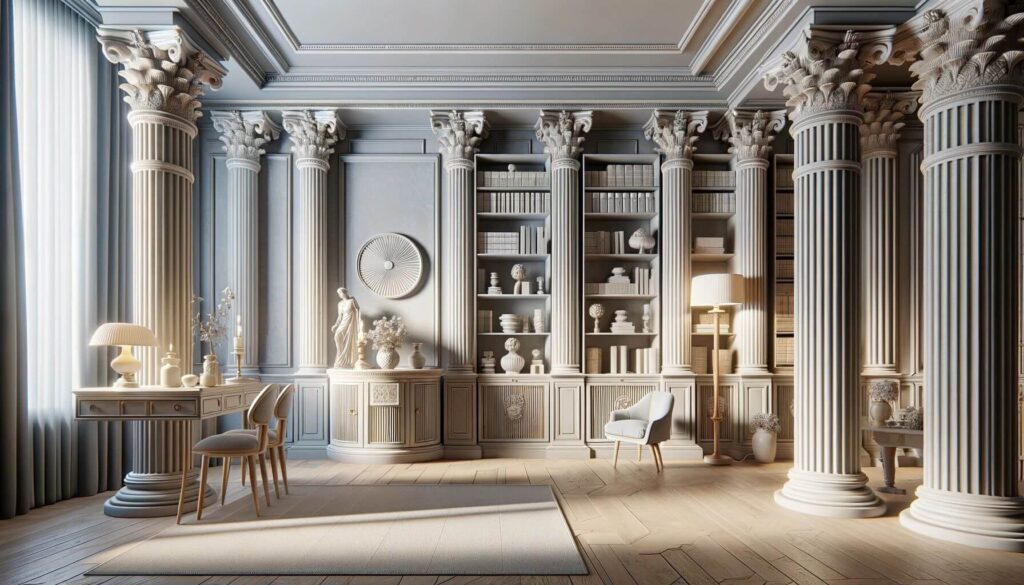
Using columns or column-inspired designs in furniture legs, architectural features, or decor items is a direct nod to the classical architecture that defines ancient Greek design. These motifs are characterized by their elegant proportions and distinctive styles: Doric, Ionic, and Corinthian. They lend a sense of grandeur and timelessness to the interior space.
Column-inspired designs can be subtly integrated into the home. This can be done through furniture legs that mimic the fluted textures of columns, bookshelves with columnar divisions, or even lamps and candleholders that take on the column’s form. Architectural features like pilasters or faux columns can define spaces. They can also create visual interest in a room without the need for structural modifications.
By incorporating Greek column motifs into the design, you weave the rich tapestry of Greek architectural heritage into the fabric of your home. This creates a space that resonates with the beauty and dignity of ancient Greece.
13. Marble Surfaces in Greece Interior Design
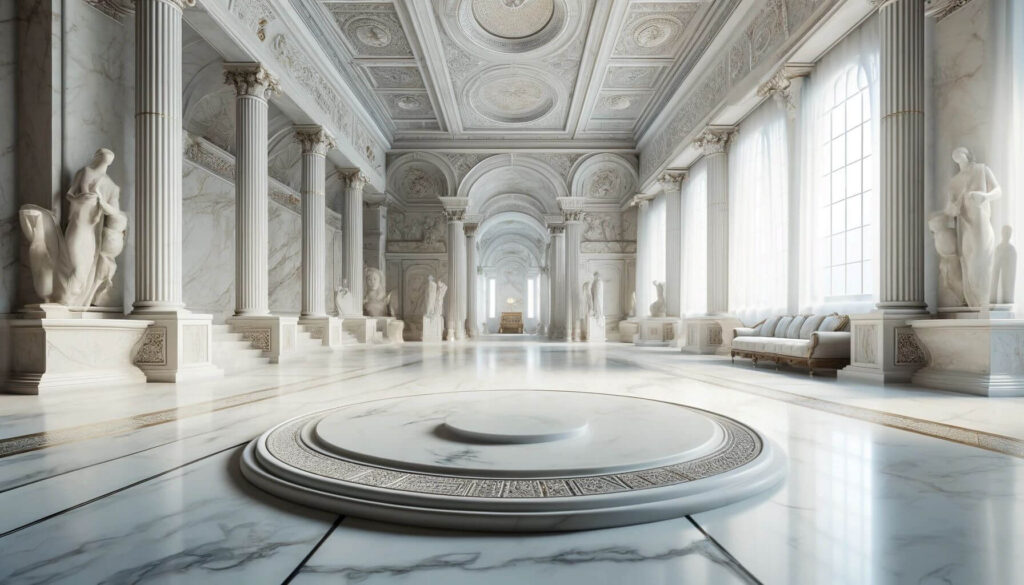
Marble has been synonymous with Greek architecture and sculpture for millennia. Its elegance and luminosity reflect the sophistication of ancient art and construction. In Greek-inspired interiors, marble surfaces bring a touch of timeless beauty and natural pattern to the space. This can be achieved through flooring, countertops, or decorative accents.
The cool touch and visual depth of marble add a luxurious feel. Its natural veining brings an art-like quality to every piece. Incorporating marble into your home pays homage to Greek heritage. It also introduces an element of nature’s artistry, making spaces feel more expansive and bright.
The use of marble in modern Greek interior design style bridges the gap between ancient grandeur and contemporary elegance. It is a perfect choice for those looking to infuse their interiors with a sense of refined beauty.
24. Fresco-Style Murals
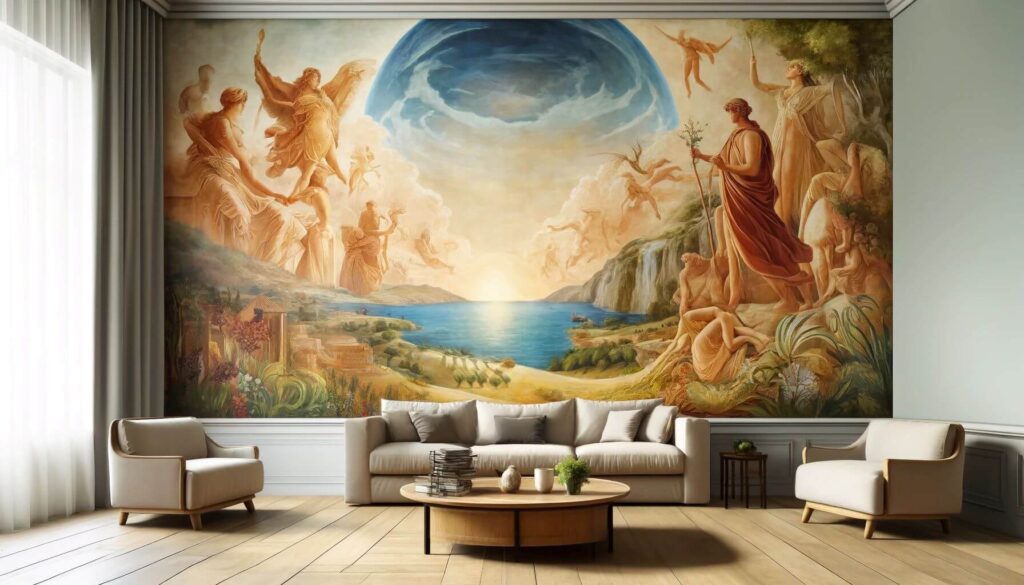
Fresco-style murals are a bold and beautiful way to bring the drama and beauty of Greek landscapes or mythological themes into your home. They are inspired by the ancient technique of painting on wet plaster. Modern frescoes can transform a wall into a stunning visual narrative. They capture the essence of Greek culture.
These murals create a focal point that is both artistic and deeply immersive. They can depict a serene Aegean seascape, a vibrant depiction of Olympian gods, or a pastoral scene from the idyllic countryside.
Adding a fresco-style mural to your Greek-style interior design elevates the room’s aesthetic. It also connects you to the rich storytelling tradition of ancient Greece. It allows you to surround yourself with images that inspire and transport.
25. Greece Interior Design with Linen Textiles
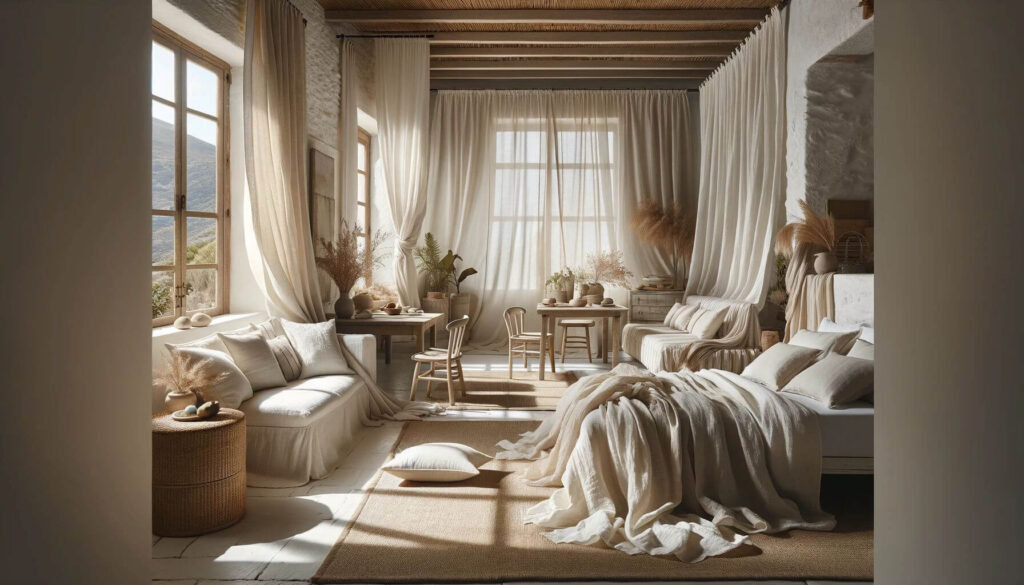
Linen textiles are a staple in Greek-inspired interiors. They are celebrated for their natural, breathable quality that perfectly complements the Mediterranean lifestyle. Choosing linen for curtains, upholstery, bedding, and table linens introduces a texture that is both rustic and refined. It enhances the airy feel of the space while adding a layer of comfort and elegance.
The lightness of linen fabrics allows for gentle movement with the breeze. This contributes to the dynamic feel of the interior.
Their natural shades of white, beige, and soft earth tones align seamlessly with the Greek-inspired palette. They reinforce the connection to nature and simplicity.
Linen’s durability and natural elegance make it an ideal choice for creating a living space that is both welcoming and aesthetically pleasing. It embodies the relaxed yet sophisticated spirit of Greek design.
This architectural feature pays homage to the communal spirit of ancient Greek society. It also adds a distinctive, conversation-worthy element to contemporary home design. It merges the best of both worlds.
Greek Style Home Interior Design

Greek-inspired interior design style offers a unique opportunity to infuse your home with the light, serenity, and natural beauty characteristic of the Mediterranean. Each of the ideas we’ve explored provides a pathway to incorporating ancient Greek aesthetics into modern living spaces. These range from the airy elegance of breezy window treatments to the communal charm of sunken seating areas. The key to creating a personalized Greek-inspired retreat at home lies in the art of mixing and matching these elements.
The possibilities are endless. You can combine the tranquil beauty of sea and sky imagery with the rustic textures of terracotta and wood. Or, you can balance the classical grace of marble surfaces with the organic softness of linen textiles. By combining various aspects of Greek design through color, material, or form, you can curate a space that reflects both the timeless appeal of Greek culture and your personal style.
Remember also, the essence of Greek-inspired decor is not just in replicating historical accuracy. It’s about capturing the spirit of Greek living, which is harmonious, connected to nature, and deeply communal.
Let these ideas inspire you to create a Greek-themed interior design home that is not only visually striking but also a haven of relaxation and joy. It should be a place where the simplicity and elegance of the Mediterranean lifestyle can be felt in every corner. Encourage yourself to experiment and blend the old with the new. Create a living space that is uniquely yours, a true Greek-inspired retreat where life can be savored in its fullest.
FAQ Greek Interior Design for a Mediterranean Home

What colors are predominant in Greek interior design? Predominantly white and blue, complemented by earth tones and accents of olive green and terracotta.
How can I incorporate Greek style home interior design elements in a small apartment?
Focus on color, minimalism, and specific decorative items. These include terracotta pots, blue accents, and hand-painted ceramics. They capture the essence without needing extensive space.
What materials are commonly used in Greek-inspired interiors? Natural materials such as stone, marble, wood, linen, and terracotta are central to achieving the Greek aesthetic.
Can modern and Greek styles be blended?
Absolutely, the simplicity and elegance of Greek design blend well with modern aesthetics. This is through minimalist spaces, natural materials, and color schemes.
What is the best way to display Greek art in interiors?
Choose focal points for significant pieces and group smaller items in curated collections. This create visual interest without overwhelming the space.
How important is natural light in Greek interior design?
Maximizing natural light is crucial, reflecting the bright, sunlit environments of Greece. Use reflective surfaces and light colors to enhance the light in any space.
Can Greek interior design be applied to outdoor spaces?
Yes, Greek design principles like stone pathways, terracotta planters, and open, airy layouts translate beautifully to outdoor living areas.
What type of furniture works best with Greek-inspired designs? Furniture with clean lines, natural materials, and elements like wrought iron or wood with rustic finishes complement Greek interiors well.
How can I create a Greek inspired home decor in my bedroom?
Use white and blue linens, canopy beds, and art pieces reflecting Greek mythology or landscapes to create a serene, themed bedroom.
Are there any budget-friendly ways to achieve a Greek interior design look?
Focus on paint and affordable textiles in theme-appropriate colors. Consider DIY art and selective thrifted pieces like vases or small sculptures. These can bring Greek charm into your home without a large investment.

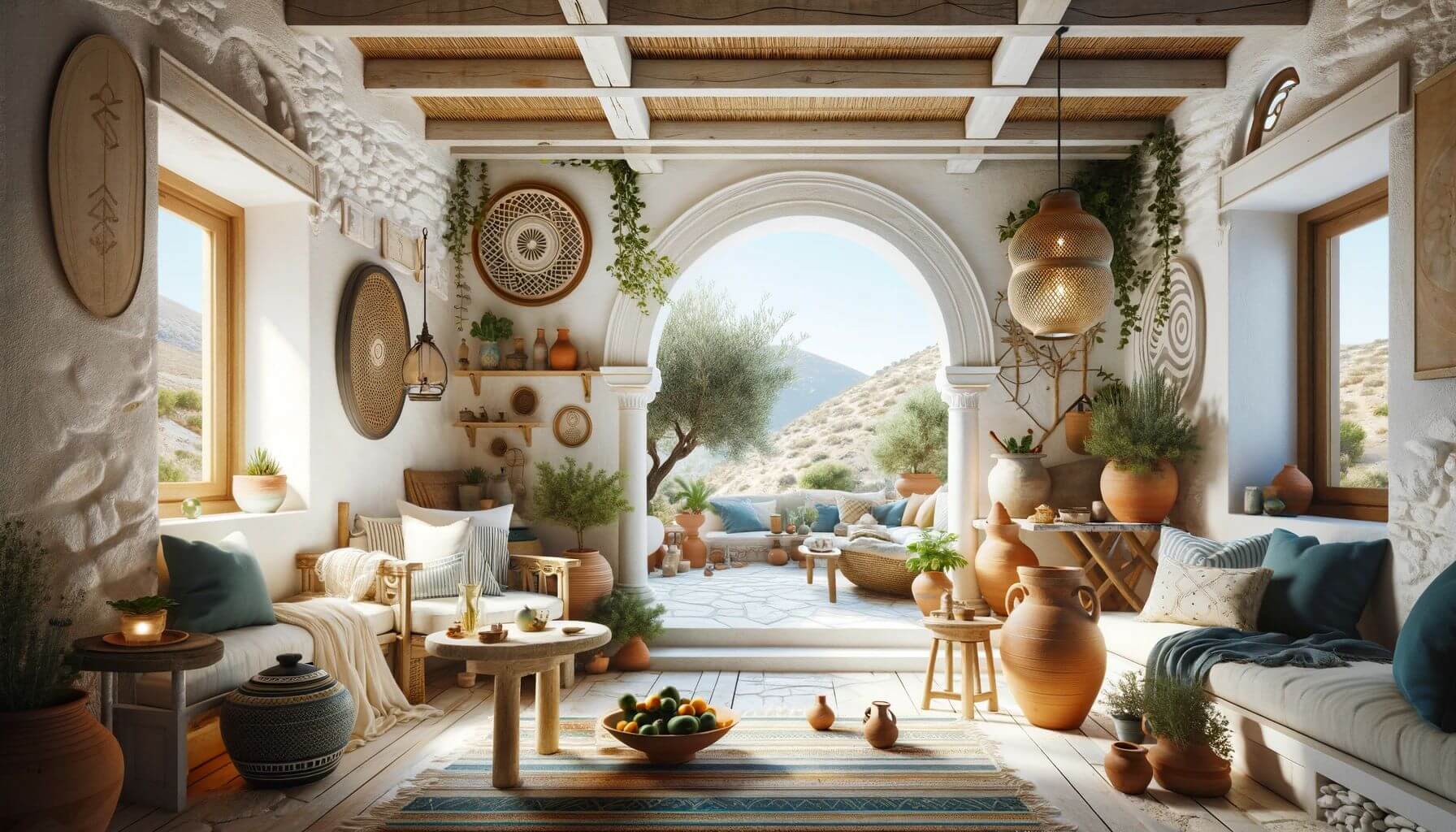
Leave a Reply